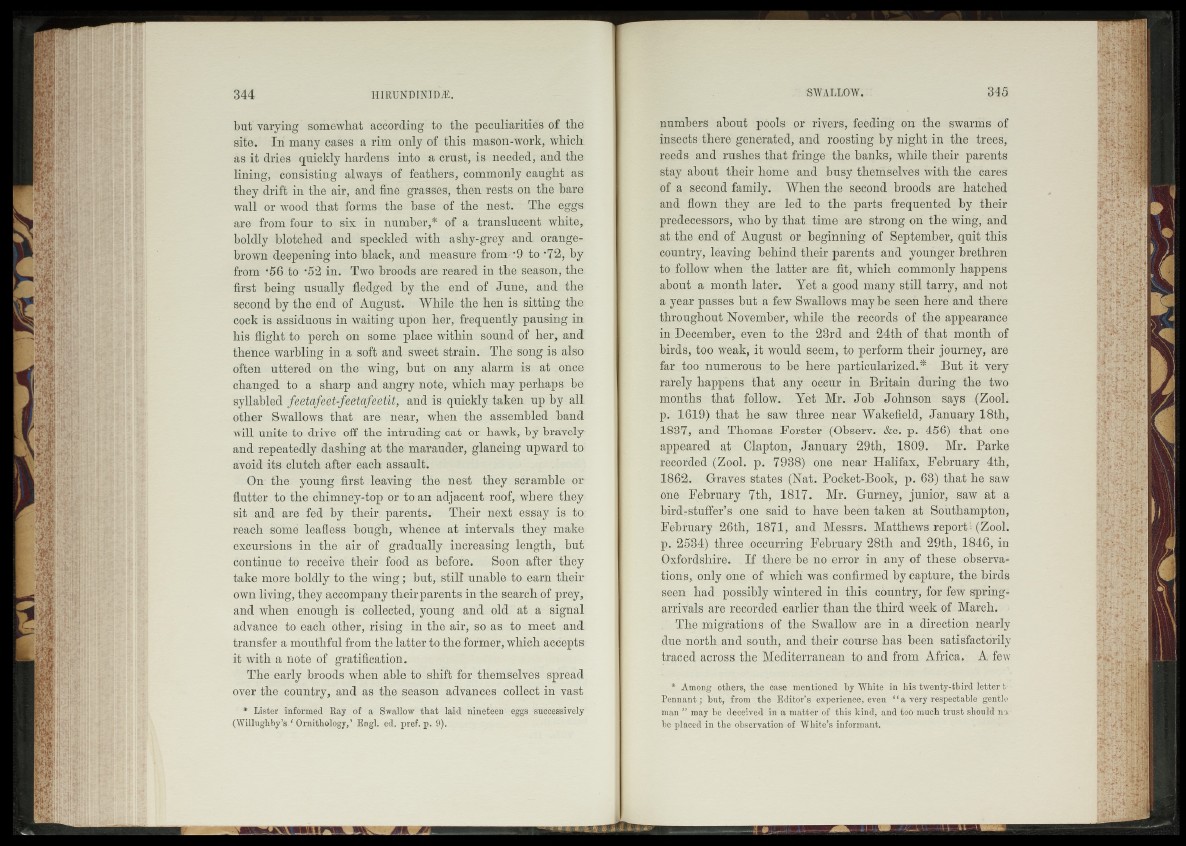
but varying somewhat according to the peculiarities of the
site. In many cases a rim only of this mason-work, which,
as it dries quickly hardens into a crust, is needed, and the
lining, consisting always of feathers, commonly caught as
they drift in the air, and fine grasses, then rests, on the hare
wall or wood that forms the hase of the nest. The eggs
are from four to six in number,* of a translucent, white,
boldly blotched and speckled with ashy-grey and orange-
brown deepening into black, and measure from *9 to *72, by
from *56 to '52 in. Two broods are reared in the season, the
first being usually fledged by the end of June, and the
second by the end of August. While the hen is sitting the
cock is assiduous in waiting upon her, frequently pausing in
his flight to perch on some place within sound of her, and
thence warbling in a soft and sweet strain. The song is also
often uttered on the wing, but on any alarm is at once
changed to a sharp and angry note, which may perhaps be
syllabled feetafeet-feetafeetit, and is quickly taken up by all
other Swallows that are near, when the assembled band
will unite to drive off the intruding cat or hawk, by bravely
and repeatedly dashing at the marauder, glancing upward to
avoid its clutch after each assault.
On the young first leaving the nest they scramble or
flutter to the chimney-top or to an adjacent roof, where they
sit and are fed by their parents. Their next essay is to
reach some leafless bough, whence at intervals they make
excursions in the air of gradually increasing length, but
continue to receive their food as before. Soon after they
take more boldly to the wing; but, still unable to earn their
own living, they accompany their parents in the search of prey,
and when enough is collected, young and old at a signal
advance to each other, rising in the air, so as to meet and
transfer a mouthful from the latter to the former, which accepts
it with a note of gratification.
The early broods when able to shift for themselves spread
over the country, and as the season advances collect in vast
* Lister informed Ray of a Swallow that laid nineteen eggs successively
(Willughby’s f Ornithology,’ Engl. ed. pref. p. 9).
numbers about pools or rivers, feeding on the swarms of
insects there generated, and roosting by night in the trees,
reeds and rushes that fringe the banks, while their parents
stay about their home and busy themselves with the cares
of a second family. When the second broods are hatched
and flown they are led to the parts frequented by their
predecessors, who by that time are strong on the wing, and
at the end of August or beginning of September., quit this
country, leaving behind their parents and younger brethren
to follow when the latter are fit, which commonly happens
about a month later. Yet a good many still tarry, and not
a year passes but a few Swallows may be seen here and there
throughout November, while the records of the appearance
in December, even to the 23rd and 24th of that month of
birds, too weak, it would seem, to perform their journey, are
far too numerous to be here particularized.* But it very
rarely happens that any occur in Britain during the two
months that follow. Yet Mr. Job Johnson says (Zool.
p. 1619) that he saw three near Wakefield, January 18th,
1837, and Thomas Forster (Observ. &c. p. 456) that one
appeared at Clapton, January 29th, 1809. Mr. Parke
recorded (Zool. p. 7938) one near Halifax, February 4th,
1862. Graves states (Nat. Pocket-Book, p. 63) that he saw
one February 7th, 1817. Mr. Gurney, junior, saw at a
birdrstuffer’s one said to have been taken at Southampton,
February 26th, 1871, and Messrs. Matthews report > (Zool.
p. 2534) three occurring February 28th and 29th, 1846, in
Oxfordshire. If there be no error in any of these observations,
only one of which was confirmed by capture, the birds
seen had possibly wintered in this country, for few spring-
arrivals are recorded earlier than the third week of March.
The migrations of the Swallow are in a direction nearly
due north and south, and their course has been satisfactorily
traced across the Mediterranean to and from Africa. A few
* Among otters, the case mentioned hy White in his twenty-third letter t
Pennant; but, from the Editor’s experience, even ‘ ‘ a very respectable gentle
man ” may be deceived in a matter of this kind, and too much trust should no,
be placed in the observation of White’s informant.